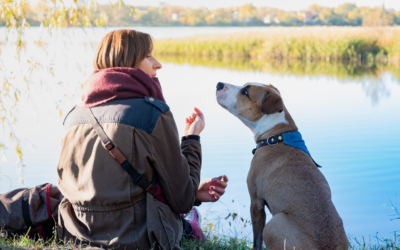If I was asked what the most misunderstood thing about dog behaviour is, I would probably say tail wagging.
I’ve overheard parents telling children that a dog is friendly because it’s tail is wagging, and have seen people walking past a very anxious dog and talking about how happy that dog is because it’s tail is wagging. Not only is this a problem because you may not recognize when an animal is anxious or fearful, it can also put people and other dogs at risk.
While I don’t know where the tail wagging = happy dog idea came from, it’s most definitely something that likely everyone has heard. Those paying close attention to behaviour and learning about the topic will know that often isn’t the case.
One of the popular early books on dog behaviour (Genetics and the Social Behavior of the Dog) even talks about tail wagging as a sign of a ‘pleasurable emotion’ towards a person or another animal and compare it to a smile. While this book is an excellent reference on some of the research we still refer to now, the opinions on tail wagging may not be completely accurate.
What does a wagging tail mean?
When asked, people will often interpret tail wagging as friendly behaviour. A study published in 2016 asked both adult dog owners and non-dog owners to interpret video of dogs with children. After watching the videos, they said that the dogs were relaxed and confident. All of the participants said that the tail wagging they saw was a positive sign in the dogs. Experts in behaviour watched the same videos and described the dogs as fearful, anxious, conflicted, or lacking confidence. It’s very likely that people watching those videos saw the tail wagging and assumed the dogs were happily interacting with the kids.
Tail wagging development
In the book mentioned earlier, the researchers also looked at how tail wagging first begins in puppies in five breeds. They found that tail wagging first began at 17 days of age in Cocker Spaniels and Shelties. Basenjis took the longest to begin wagging, beginning at 88 days of age. At one month, half of the puppies were wagging their tails.
Tail position and wagging
Many researchers have looked at different types of wagging and what they seem to mean. For example, fast tail wags are often seen in dogs that are very excited, while loose wide wags are often a sign of friendliness in dogs.
Lowered tails, however, mean something different. A tail that is lower than the dogs’ back and moving slowly likely means a dog is insecure and not sure what to do, or is perhaps in pain or not feeling well. A tail sticking straight back likely means a dog is paying attention to something or could be a sign that the dog might respond aggressively.
Tail wagging communication between dogs
Not only can dog wagging communicate with us the emotional state of the dog, but it’s also important for communication between dogs. In order to look at this, researchers used a robot dog that looked like a lab, with either a still or wagging tail. There were also two lengths of tail the robot could have, one that was normal and one shortened or docked. Small dogs were not very likely to approach the robot dog. Large dogs were more likely to approach the robot with a long tail that was wagging, compared to still. If the robot had the shortened tail, then the dogs would approach either way. The researchers concluded that communication between dogs from tails is more effective if the tail is longer.
This has implications for dogs that are bred to have short tails or those that are docked, in that they may not be able to communicate with other dogs as well.
Tail wagging asymmetry
We also know that not all tail wagging happens in the same way. Dogs have asymmetric wagging, meaning that they may wag more to the left or the right in different circumstances.
One study looked at this behaviour and found differences in dogs based on what they were looking at. Dogs that were looking at people or at a cat wagged more to the right side. They wagged the most enthusiastically with familiar people and least enthusiastically with cats. Dogs that were looking at a large, unfamiliar dog wagged more to the left side.
There is also research showing that this asymmetric wagging may be an important type of communication between dogs. Dogs were shown video of other dogs wagging their tails, and their heart rates and behaviour were recorded. Those that watched left-biased tail wagging showed higher heart rates and also showed more anxious behaviour. Dogs that watched right-biased tail wagging had lower heart rates and more relaxed behaviour.
If you’re interested in more of the science behind this blog post, visit The Behaviory Blog which is my blog written for pet professionals, and covers the topic in greater depth.



